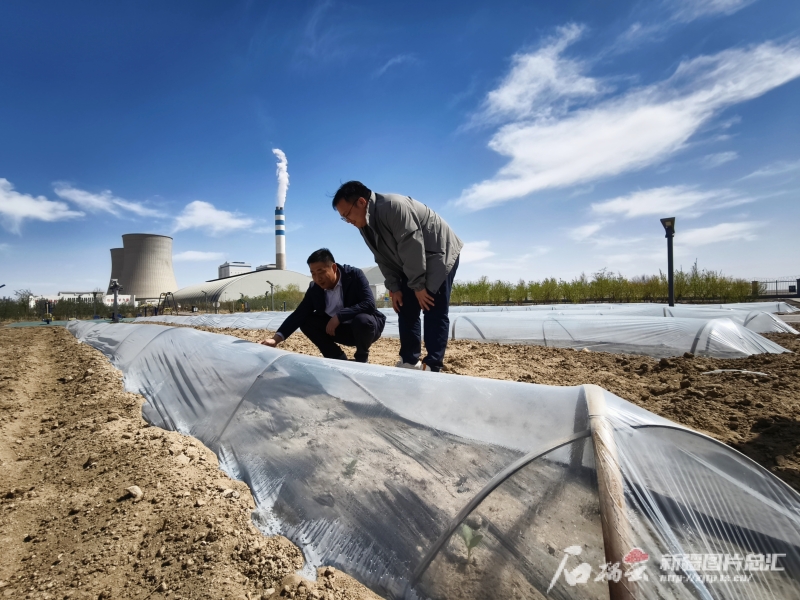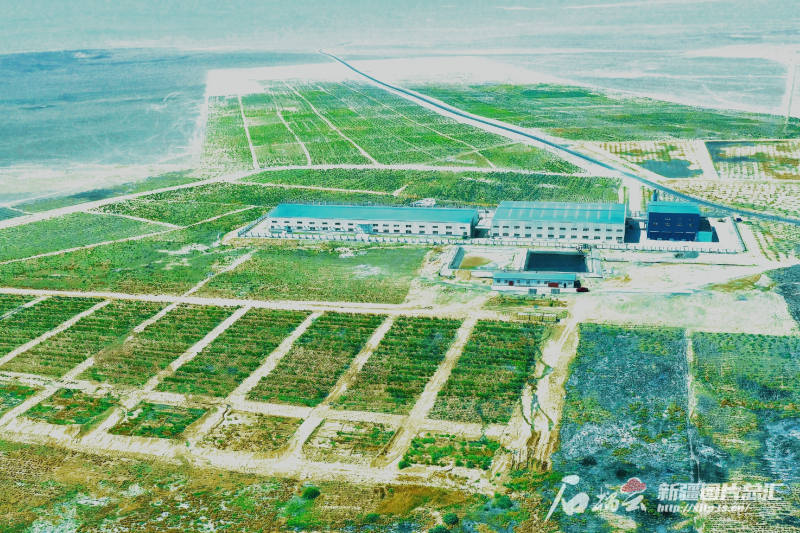Shiliuyun- Xinjiang Daily (Reporter: Wei Yonggui, Cprrespondent: Guo Ziyi) news: On April 24, 2025, the Gobi Desert in the southern part of Hami, northwest China’s Xinjiang Uygur Autonomous Region, was scorching with heat waves. This wasteland, adjacent to Lop Nur, is typically perceived as a quintessential barren land in people’s minds.
Vehicles sped down the highway from Hami to Lop Nur, with dust swirling on either side of the road as the wheels churned. The hustle and bustle of the city gradually faded into the distance. Under the blazing sun, the Gobi Desert, strewn with gravel, stretched out boundlessly.
An hour and a half later, the vehicle turned onto an unnamed road, which is a mining-specific road built by the Hami Energy Co., Ltd. of Xuzhou Coal Mining Group. After traveling along this road for 20 minutes, the scenery changed dramatically. Large patches of white thorns, saxauls, and red willows appeared abruptly. Tall factory buildings and coal silos stood at the end of the road. In the distance, the cooling towers of the thermal power plant were emitting plumes of white steam.
This place is already deep in the Gobi Desert, where the sandy soil is covered with a layer of white alkali and the air is hot and dry. Upon closer inspection, rows of shrubs have drip irrigation hoses laid at their roots, with the streams of water tirelessly moistening the soil.
"The water comes from underground. The high-salinity mine water, after preliminary treatment, is the lifeblood of this vegetation," Shi Junliang, head of the Environmental Protection Department of Hami Energy Co., Ltd. of Xuzhou Coal Mining Group, explained.

Photo taken on April 11, 2025 shows the young seedlings of Hami melons and watermelons in a small arch greenhouse are about to break through the soil at the factory of Hami Energy Co., Ltd. of Xuzhou Coal Mining Group in northwest China’s Xinjiang Uygur Autonomous Region.
The vibrant life deep in the Gobi Desert
The coal mines, coal silos, office buildings, dormitory buildings, water treatment plants, and other facilities of Hami Energy Co., Ltd. of Xuzhou Coal Mining Group are centrally located. The factory area is spacious and tidy, with little dust on the ground. The temperature here is also a few degrees cooler than that of the Gobi Desert.
"The improvement of the environment here is thanks to the greening efforts both inside and outside the factory," Shi Junliang said. He added that the 14.7-hectare green space outside the factory has already formed a "green island" in the Gobi Desert.
Standing on the green space viewing platform and looking into the distance, one can see large areas of saxaul forests and red willows swaying in the wind. Among the shrubs, birds occasionally take flight and flap their wings. On the artificial lake not far away, egrets dance gracefully.
Within the factory area, in addition to the green belts around the roads and buildings, there is an orchard planted with apples, red dates, pears, and apricots. In several fields covered with mulch film, the seedlings of Hami melons and watermelons are about to break through the soil.
"Our employees planted these. Every July and August, we hold a harvest festival where everyone picks fruits and melons and enjoys delicious food. It has become a tradition," Shi Junliang said. He introduced that the fruit trees and melon seedlings are growing well this year, and the harvest festival is expected to be held in early July.
"We also have a fish pond where employees can go fishing on weekends," Wei Rizhong, assistant to the head of the Environmental Protection Department of the company, said.
The fish pond is located next to a newly built small park, adjacent to a fitness trail and a lawn. In the several hundred square meters of pond, fish occasionally leap out of the water, with some being over a foot long.
"The fish are raised by us, and we feed them on schedule, so they're growing well," Shi Junliang said. He said that the factory area is far from the city, and building a fish pond not only enriches the employees' lives but also demonstrates the company's ecological philosophy and greening achievements.

Photo taken on April 11, 2025 shows the high-salinity mine water, after treatment, is clear and transparent at the mine water treatment plant of Hami Energy Co., Ltd. of Xuzhou Coal Mining Group in northwest China’s Xinjiang Uygur Autonomous Region.
The birth process of "sweet spring"
The key to greening is water. Hami Energy Co., Ltd. of Xuzhou Coal Mining Group has made great efforts in this regard.
During the mining process of the Dananhu No. 5 coal mine, a large amount of mine water is generated. The original design capacity of the water treatment facilities was 2,000 cubic meters per day. However, the actual inflow of water far exceeded the designed value, making the existing facilities unable to meet the demand. The company immediately increased its investment and upgraded the daily treatment capacity to 10,800 cubic meters, ensuring normal production.
However, new challenges soon followed. The Dananhu Gobi, adjacent to Lop Nur, has highly saline soil. Combined with the accumulation of salt over thousands of years, this has formed a salt crust several meters thick. The salinity of the groundwater is generally high, with the average salt content of the mine's groundwater reaching 16 grams per liter. The high-salinity mine water has thus become a barrier for both production and ecology.
In 2019, the company invested 160 million yuan (about 22 million U.S. dollars) to build a new mine water treatment plant. It adopted a process that can deeply treat the high-salinity mine water through sedimentation, concentration, and desalination. The pitch-black mine water, mixed with powdered coal ash, became clear after passing through these processes.

File photo taken in July 2024 shows the green landscape of Hami Energy Co., Ltd. of Xuzhou Coal Mining Group in northwest China's Xinjiang Uygur Autonomous Region.. (Photo by Guo Ziyi)
Overcoming difficulties and achieving success in afforestation
After resolving the issue of water source, large-scale greening was put on the agenda. However, planting trees in such a highly saline environment is far from easy.
In the Dananhu area, the average salt content in the surface soil exceeds 100 grams per kilogram, making it difficult for ordinary plants to survive. When salt dissolves in water, it easily forms cavities, which can lead to the rotting of plant roots. Moreover, the dry and hot winds in the Gobi Desert during spring, summer, and autumn are the "natural enemies" of plants.
"We collaborated with the Xinjiang Institute of Ecology and Geography of the Chinese Academy of Sciences to form a joint research team. We identified 10 salt-tolerant pioneer plants, including saxaul and red willow," Wei Rizhong recalled. In 2022, the team first carried out a trial planting on a 3.3-hectare land. After preliminary treatment of the high-salinity mine water, they controlled the soil salinity distribution by regulating the drip irrigation flow and watering time. They also applied microbial coatings at the plant roots to enhance salt tolerance. These innovative techniques successfully solved the challenges of cultivating in highly saline soil.
A year later, the survival rate of plants in the experimental field reached 52 percent, meeting the expected target. In 2023 and 2024, the greening area continued to expand, reaching a total of 150 hectares, with more than 20 million yuan (about 2.7 million U.S. dollars) invested in the process. The company has established a professional maintenance team to ensure the long-term sustainability of the green spaces.
"The more than 133 mu of green vegetation have attracted wild animals such as foxes and hares, and some migratory birds like egrets have roosted by the artificial lake for two consecutive years," Shi Junliang said. It has been estimated that the green areas fix 1,800 tons of carbon and intercept 120,000 tons of dust and sand annually, and the number of days with good air quality in the mining area has increased by 46.
The improvement of the ecological environment has inspired the enthusiasm of the employees, who have spontaneously planted trees in the factory area. The company has also been developing better and better.
In March 2024, the Dananhu No. 5 Coal Mine of Hami Energy Co., Ltd. of Xuzhou Coal Mining Group passed the green mine acceptance of Xinjiang with a high score. This year, the company's project of "Ecological Management and Resource Utilization of High Salinity Mine Water in Saline Areas" was selected into the typical case library of ecological restoration of territorial space in Xinjiang, becoming the first large-scale greening and afforestation demonstration project with the water source from high-salinity mine water in Xinjiang.
(A written permission shall be obtained for reprinting, excerpting, copying and mirroring of the contents published on this website. Unauthorized aforementioned act shall be deemed an infringement, of which the actor shall be held accountable under the law.)









